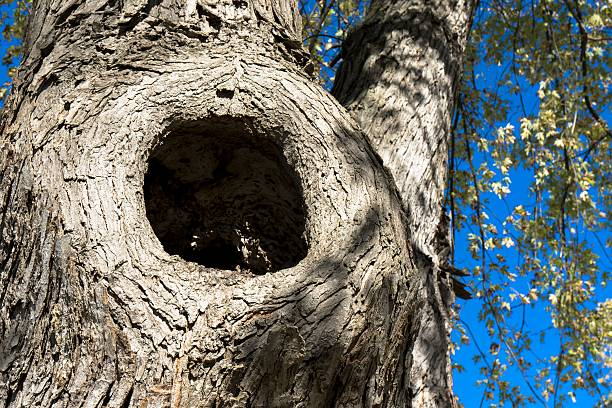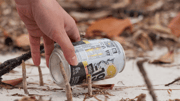
While politicians debate Australia's human housing shortage, there's another accommodation crisis unfolding in our backyards. Our native wildlife is being squeezed out of their homes, and some innovative councils are taking matters into their own hands with a rather ingenious solution.
More than 360 species of mammals and birds worldwide make their homes in tree hollows—including 90 per cent of Australia's parrots.
But here's the rub: natural hollows take a minimum of 70 to 120 years to start forming, with some eucalypts like river red gums taking at least a century.
Urban development typically results in a reduction of hollow-bearing trees and increased competition among wildlife, with urban remnants showing significantly higher usage rates and more aggressive interactions than continuous forest areas.
Lake Macquarie Council alone removes between 1,000 and 2,000 trees every year from natural areas and suburban streets, replacing only about 60.
In this article
'People need houses, and we've got a housing crisis. But so do animals. We're trying to find homes for people, we're trying to find homes for animals, and this is one way we can sort of have both.'
The revolutionary drill that's changing the game
Enter the HollowHog—an Australian-invented tool that's turning the tree hollow shortage on its head. This high-speed cutting head with tungsten carbide tips spins at around 11,000 rpm to carve into wood, creating entrance holes that open into much larger internal cavities.
Lake Macquarie City Council has embraced this technology as part of their Hollow Augmentation Program. 'It's a bit like keyhole surgery—it's a relatively narrow opening, which a lot of our native fauna prefers, but it opens up into an area large enough for birds or mammals to nest and for young to grow,' explains Simon Lubinski.
The precision is remarkable. Through a small entrance hole, operators can carve cavities up to 90 centimetres tall and 45 by 90 centimetres wide—'a massive internal cavity for a tiny little entrance.'
How the HollowHog works
The tool creates a 50mm entry hole, then progressively carves larger hollows up to 600mm wide, long and deep. The cavity shape adapts to the tree's size, and importantly, causes minimal disruption to the tree's living tissue, allowing continued growth around the artificial hollow.
From trial to triumph
The program began as a pilot in late June near the Landcare and Sustainable Living Centre at Teralba, and is expanding to sites at Kahibah and Charlestown. The council aims to create 50 to 60 hollows annually across the city's natural areas.
The species list reads like a who's who of Australian wildlife: sugar gliders, feathertail gliders, squirrel gliders, microbats, rainbow lorikeets, rosellas, and native parrots.
Early monitoring has already captured various animals using the artificial hollows, including parrots, marsupials like antechinus, and even a lace monitor lizard taking a curious peek inside.
A movement across the continent
Lake Macquarie isn't alone in this endeavour. Randwick City Council in Sydney has installed state-of-the-art nesting boxes, with rainbow lorikeets spotted nesting within weeks of installation. Arborists in Sydney are working with around 10 councils so far, with others showing interest.
The New South Wales National Parks and Wildlife Service, Department of Primary Industry, and various Landcare groups have already adopted HollowHog technology. To date, thousands of hollows carved by HollowHog tools have been installed around Australia.
Why artificial hollows matter
- Over 300 native species rely on tree hollows for shelter and nesting
- Natural hollow formation takes 70-120+ years
- Urban development removes hollow-bearing trees faster than nature can replace them
- Artificial hollows can be created in under an hour and last 200-300 years
- They provide better thermal stability than thin-walled nest boxes
The bigger picture: from crisis to hope
Australia holds the shameful distinction of having the world's worst mammal extinction rate, with iconic animals like koalas and greater gliders being pushed toward extinction as forest habitat continues to be destroyed.
Habitat loss has significantly impacted Australia's small mammals over the last century, with over 100 species declared extinct or extinct in the wild since European settlement.
But there's a growing recognition that artificial hollows provide safe, sheltered spaces particularly important in urban areas where natural tree cavities are scarce due to land clearing.
'The very first time I ever got my hands on a HollowHog and actually started carving, it really filled me with hope that my career doesn't have to be all about cutting trees down.'
More than just housing
Professor Sarah Bekessy from RMIT's Centre for Urban Research has been advocating for a fundamental shift in how we approach urban development.
Rather than viewing biodiversity as a constraint, she argues we should maximise nature connection opportunities in planning processes.
Tree hollows have been demonstrated to remain cooler on hot days and warmer on cool ones than thin-walled nest boxes—a critical attribute for fauna survival in harsh conditions.
Unlike static nest boxes, HollowHog-created hollows can grow in size along with the tree as it wraps tissue around the carved hollow, maintaining stability over centuries.
Did you know?
Did you know?
Each artificial hollow created today could potentially last 200-300 years and produce a new generation of fauna annually. [20] That's a remarkable return on investment for wildlife conservation.
Getting involved in your community
While specialised tools like the HollowHog require professional operators, there are ways residents can support urban wildlife housing initiatives. Many councils are expanding their programs and welcome community input on suitable locations and species priorities.
Wildlife experts describe nest boxes and artificial hollows as 'critical' and cost-effective ways to give back to nature, particularly as our cities continue to expand.
The key is proper planning—different wildlife species have various preferences when selecting tree hollows, so consultation with local ecologists and biodiversity officers helps determine the most appropriate species to target in any given area.
As our cities grow and the human housing crisis deepens, it's heartening to see councils like Lake Macquarie recognising that we share this space with countless other residents who also need homes.
The HollowHog might sound like an odd solution, but it's proving to be a game-changer for urban wildlife conservation.
Have you noticed more wildlife activity in your local area since council conservation programs began? Or perhaps you've spotted some interesting native animals that might benefit from more suitable housing options? We'd love to hear about your local wildlife observations and any conservation initiatives in your community.
Original Article
https://au.news.yahoo.com/council-s...quiet-crisis-in-aussie-suburbs-202427556.html
Urban real estate guide for empty nesters—The Australian Museum Blog
Cited text: More than 360 species of mammals and birds worldwide make their homes in tree hollows—including 90 per cent of Australia’s parrots.
Excerpt: More than 360 species of mammals and birds worldwide make their homes in tree hollows—including 90 per cent of Australia's parrots.
https://australian.museum/blog-archive/science/amri-urban-real-estate-guide/
World’s first that’s saving Australia’s wildlife one treehole at a time
Cited text: According to Stephens, a natural hollow would take a minimum of 70 to 120 years to start forming.
Excerpt: natural hollows take a minimum of 70 to 120 years to start forming, with some eucalypts like river red gums taking at least a century.
https://www.nationthailand.com/world/asia-pacific/40024871
Creating hollows for wildlife with chainsaws—Sustainable Macleod
Cited text: For example, river red gums (Eucalyptus camaldulensis) which are local to our area and many other parts of our country, take at least a hundred years ...
Excerpt: natural hollows take a minimum of 70 to 120 years to start forming, with some eucalypts like river red gums taking at least a century.
https://sustainablemacleod.org.au/creating-hollows-for-wildlife-with-chainsaws/
Housing Shortages in Urban Regions: Aggressive Interactions at Tree Hollows in Forest Remnants—PMC
Cited text: Urbanisation typically results in a reduction of hollow-bearing trees and an increase in the density of particularly species, potentially resulting in...
Excerpt: Urban development typically results in a reduction of hollow-bearing trees and increased competition among wildlife, with urban remnants showing significantly higher usage rates and more aggressive interactions than continuous forest areas.
https://pmc.ncbi.nlm.nih.gov/articles/PMC3605434/
Housing Shortages in Urban Regions: Aggressive Interactions at Tree Hollows in Forest Remnants—PMC
Cited text: Hollows within urban remnants were characterised by significantly higher usage rates and significantly more aggressive interactions than hollows withi...
Excerpt: Urban development typically results in a reduction of hollow-bearing trees and increased competition among wildlife, with urban remnants showing significantly higher usage rates and more aggressive interactions than continuous forest areas.
https://pmc.ncbi.nlm.nih.gov/articles/PMC3605434/
Hollow Augmentation program offers fauna homes in Lake Macquarie | Dungog Chronicle | Dungog, NSW
Cited text: Lake Macquarie Landcare coordinator Simon Lubinski said the council removed between 1000 and 2000 trees every year from natural areas and suburban str...
Excerpt: Lake Macquarie Council alone removes between 1,000 and 2,000 trees every year from natural areas and suburban streets, replacing only about 60.
https://www.dungogchronicle.com.au/...program-offers-fauna-homes-in-lake-macquarie/
World’s first that’s saving Australia’s wildlife one treehole at a time
Cited text: The Hollowhog is a high-speed cutting head with tungsten carbide tips that spins at a rate of around 11,000 rpm to carve into the wood of the tree, cr...
Excerpt: This high-speed cutting head with tungsten carbide tips spins at around 11,000 rpm to carve into wood, creating entrance holes that open into much larger internal cavities.
https://www.nationthailand.com/world/asia-pacific/40024871
Boring project gives critters a hole lot of spring living options—Eco News
Cited text: A specialised tool called a HollowHog is used to create the hollows. It drills a small opening on the host tree’s trunk, then bore a much larger cavit...
Excerpt: 'It's a bit like keyhole surgery—it's a relatively narrow opening, which a lot of our native fauna prefers, but it opens up into an area large enough for birds or mammals to nest and for young to grow,' explains Simon Lubinski.
https://econews.com.au/67697/boring-project-gives-critters-a-hole-lot-of-spring-living-options/
World’s first that’s saving Australia’s wildlife one treehole at a time
Cited text: 'Through that entrance hole, I can carve down that way, up that way, sideways, so I could get, in this instance, a 90-centimetre tall hollow by 45 by ...
Excerpt: Through a small entrance hole, operators can carve cavities up to 90 centimetres tall and 45 by 90 centimetres wide—'a massive internal cavity for a tiny little entrance.'
https://www.nationthailand.com/world/asia-pacific/40024871
Hollow Augmentation program offers fauna homes in Lake Macquarie | Dungog Chronicle | Dungog, NSW
Cited text: The program, which was piloted in late June in Teralba near the Landcare and Sustainable Living Centre, will be expanded to Landcare sites at Kahibah ...
Excerpt: The program began as a pilot in late June near the Landcare and Sustainable Living Centre at Teralba, and is expanding to sites at Kahibah and Charlestown.
https://www.dungogchronicle.com.au/...program-offers-fauna-homes-in-lake-macquarie/
World’s first that’s saving Australia’s wildlife one treehole at a time
Cited text: After installing a camera opposite one of the Hollowhog hollows, Stephens has seen various animals use it, including parrots like Rainbow Lorikeets, R...
Excerpt: Early monitoring has already captured various animals using the artificial hollows, including parrots, marsupials like antechinus, and even a lace monitor lizard taking a curious peek inside.
https://www.nationthailand.com/world/asia-pacific/40024871
Tree hollows for habitat | Sustainable Gardening Australia
Cited text: Arborists in Sydney are working with around 10 councils so far, with others showing interest.
Excerpt: Arborists in Sydney are working with around 10 councils so far, with others showing interest.
https://www.sgaonline.org.au/artificial-tree-hollows-for-animal-habitat/
World’s first that’s saving Australia’s wildlife one treehole at a time
Cited text: The New South Wales National Parks and Wildlife Service has already started using the Hollowhog to create much-needed habitats for Australia’s wildlif...
Excerpt: The New South Wales National Parks and Wildlife Service, Department of Primary Industry, and various Landcare groups have already adopted HollowHog technology.
https://www.nationthailand.com/world/asia-pacific/40024871
World’s first that’s saving Australia’s wildlife one treehole at a time
Cited text: To date, thousands of hollows carved by Hollowhog tools have been installed around Australia.
Excerpt: To date, thousands of hollows carved by HollowHog tools have been installed around Australia.
https://www.nationthailand.com/world/asia-pacific/40024871
The Story of Australia’s Extinction Crisis So Far—How Our Nature Laws Are Failing | The story of Australia’s extinction crisis so far | WWF Australia
Cited text: Australia’s environmental reputation is shameful, as we claim the top spot of having the world’s worst mammal extinction rate. Iconic animals like the...
Excerpt: Australia holds the shameful distinction of having the world's worst mammal extinction rate, with iconic animals like koalas and greater gliders being pushed toward extinction as forest habitat continues to be destroyed.
https://wwf.org.au/blogs/the-story-of-australias-extinction-crisis-so-far/
Aussies urged to make one 'critical' backyard change to combat national crisis
Cited text: Habitat loss has significantly impacted Australia's small mammals in the last century, including countless marsupials, birds and rodents. Since Europe...
Excerpt: Habitat loss has significantly impacted Australia's small mammals over the last century, with over 100 species declared extinct or extinct in the wild since European settlement.
https://au.news.yahoo.com/aussies-u...ange-to-combat-national-crisis-053451690.html
Aussies urged to make one 'critical' backyard change to combat national crisis
Cited text: McGlashan said nest boxes provide a safe, sheltered space for birds and small mammals to nest and raise their young, especially in urban or suburban a...
Excerpt: artificial hollows provide safe, sheltered spaces particularly important in urban areas where natural tree cavities are scarce due to land clearing.
https://au.news.yahoo.com/aussies-u...ange-to-combat-national-crisis-053451690.html
Hollow Hog
Cited text: Tree hollows have been demonstrated to remain cooler on hot days and warmer on cool ones than thin-walled nest boxes. For some fauna this attribute is...
Excerpt: Tree hollows have been demonstrated to remain cooler on hot days and warmer on cool ones than thin-walled nest boxes—a critical attribute for fauna survival in harsh conditions.
World’s first that’s saving Australia’s wildlife one treehole at a time
Cited text: Whereas those created by the Hollowhog are able to grow in size along with the tree as it grows and wraps its tissue around the carved hollow, all the...
Excerpt: Unlike static nest boxes, HollowHog-created hollows can grow in size along with the tree as it wraps tissue around the carved hollow, maintaining stability over centuries.
https://www.nationthailand.com/world/asia-pacific/40024871
World’s first that’s saving Australia’s wildlife one treehole at a time
Cited text: And to think that then that hollow that we have created may last potentially two or three hundred years into the future, and each year producing anoth...
Excerpt: Each artificial hollow created today could potentially last 200-300 years and produce a new generation of fauna annually.
https://www.nationthailand.com/world/asia-pacific/40024871
Aussies urged to make one 'critical' backyard change to combat national crisis
Cited text: Speaking to Yahoo News Australia, wildlife enthusiast Alice McGlashan said nest boxes — small, man-made structures designed to provide a safe place fo...
Excerpt: Wildlife experts describe nest boxes and artificial hollows as 'critical' and cost-effective ways to give back to nature
https://au.news.yahoo.com/aussies-u...ange-to-combat-national-crisis-053451690.html
Tree hollows for habitat | Sustainable Gardening Australia
Cited text: Different wildlife species have various preferences when selecting tree hollows to use, which means we can create hollows with a particular species in...
Excerpt: different wildlife species have various preferences when selecting tree hollows, so consultation with local ecologists and biodiversity officers helps determine the most appropriate species to target in any given area.
https://www.sgaonline.org.au/artificial-tree-hollows-for-animal-habitat/







